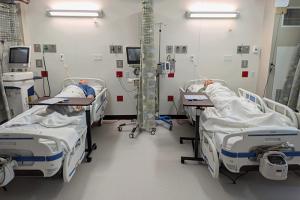Top five findings in care environments

Top issues cited by CIHQ under the National Fire Protection Association’s Life Safety Code include inspection of sprinkler system components.
Image by Getty Images
The Center for Improvement in Healthcare Quality (CIHQ) is an accreditation organization (AO) that has deeming status to accredit acute care hospitals, critical access hospitals and acute psychiatric hospitals.
It conducted more than 60 surveys over all three programs in 2024.
This article discusses the top five standard- and condition-level deficiencies that were found by CIHQ during the year, listed in order of the most-frequently cited.
Improving compliance
These deficiencies are not a surprise to those who work in health care facilities. Unfortunately, the issues don’t seem to change much from year to year. Why do health care facilities continue to struggle with these regulatory requirements? The following provides a deeper look at them and how health care facilities can improve compliance:
1. CE-15: Compliance with the National Fire Protection Association’s NFPA 101®, Life Safety Code® (standard-level deficiency, Requirement A, which aligns with the Centers for Medicare & Medicaid Services (CMS) A-0710). Any noncompliance to a requirement that is directly from NFPA 101-2012 is cited by CIHQ under this standard. Additionally, noncompliance to a requirement from any NFPA 101-2012 referenced code (other than NFPA 99, Health Care Facilities Code) is always cited under this standard. At the time of data collection, CIHQ also would cite any inspection, testing and maintenance activities that were not listed in CE-19 under this standard. (This was changed in the 2025 CIHQ standards update). CIHQ also focuses on the CMS K-tags (CMS Form 2786r) K-100 through K-791 for this standard.
The top issues cited include:
- Barrier management, with penetrations not properly sealed and fire barrier doors not latching.
- Sprinkler piping supporting other items.
- Kitchen equipment not having a device to ensure proper placement after being moved for cleaning.
- Movable kitchen gas equipment that is not tethered.
- Inspection of sprinkler system components (e.g., gauges and valves).
Health care facilities say there are two main reasons they are noncompliant with these and other requirements: lack of knowledge and/or mistakenly trusting a vendor to ensure compliance. It is important that health care facilities staff have a good understanding of regulatory requirements.
Facilities potentially will have many people working above their ceilings. Those that have successfully addressed these issues use an efficient validation program. A barrier management work permit process offers many advantages.
When health care facilities can tie a deficiency to a monetary consequence, it can motivate the vendor to ensure compliance. For example, there could be a reduced fee or no payment if a vendor does not properly seal a penetration through a rated barrier based on an above-the-ceiling permit process.
Buildings continue to get older every year. With age comes wear and tear on equipment and inadvertent damage. This often is seen with fire doors. They may be hit by carts or beds daily. The building may settle or shift. These may lead to problems with door latching. Health care facilities should perform frequent inspections of those doors rather than waiting for the code-required annual inspection.
Often, it is too late, and the AO comes into a facility and discovers the doors not working properly. Additionally, there are occasions when things just happen. For instance, the health care facilities staff inspected the door the morning a surveyor arrives, and it worked. Then, a staff member accidentally ran into the door while moving equipment, and the door no longer works properly. Unfortunately, there is not much the facilities staff can do in this instance.
Kitchen equipment can be dangerous and may lead to fire hazards. Maintaining a clean environment can help reduce that likelihood. Therefore, kitchen staff will move equipment to clean under and around cooking appliances. As a result, the staff needs to ensure that equipment is placed back into the proper position to be covered by the sprinkler system as it was designed.
Staff members in this area need an engineering control to help them. The code requires a mechanism to ensure that the equipment is put back in the right location. Additionally, when staff is moving cooking equipment that is connected to a gas line, there must be a tether to prevent them from accidentally pulling the equipment too far, disconnecting the gas line.
When health care facilities hire vendors to test their systems, they assume that every inspection, testing process and maintenance requirement is complete. However, this is not always the case. There are many inspection requirements in various NFPA codes. Health care facilities must know these inspections and their frequencies.
They usually are not performed by the vendor and can be performed by a qualified and educated facilities staff member. For instance, health care facilities must perform monthly visual inspections of all wet pipe fire sprinkler system pressure gauges. This ensures they are working properly and within proper pressures. Documentation must be provided for this inspection.
2. CE-21: Compliance with NFPA 99, Health Care Facilities Code (standard-level deficiency, requirements A and F, which align with CMS A-0720). While there are many deficiencies that come under this requirement, there are two that happen more frequently than others.
The first is lack of a risk assessment of equipment to determine whether the category it has been assigned ensures proper installation, inspection, maintenance and testing requirements. CIHQ will look for this requirement anytime there has been a new building or improvements to an existing system that would require it to be brought up to new code. (These are for systems that were installed after July 5, 2016.)
The second is lack of proper signage where oxygen cylinders are being stored. This requires the enclosure to have signage on its outside to assist emergency staff who may need to know what is inside before they enter the room. Facilities staff should refer to Chapter 11 of NFPA 99-2012 for the required language.
3. CE-1: Provision of Facilities (standard-level deficiency, requirements A and E, which align with CMS A-0722). The most common deficiencies for this standard come because of eyewash stations and water management programs.
For eyewash stations, CIHQ utilizes the American National Standards Institute’s ANSI Z358.1 as its inspection tool. During surveys, corrosive chemicals will be in areas where staff members are using them. When the chemicals are discovered, surveyors will determine if and where the nearest eyewash station is located. Typically, the nearest eyewash station is behind a closed and locked door. Health care facilities need to assess their corrosive materials and determine where eyewash stations are required. The eyewash station placement must meet the requirements of ANSI Z358.1. While CIHQ does not cite health care facilities for having eyewash stations in locations where they are not needed, the assessment from the AO could be to eliminate ones that are not needed.
Water management programs are being cited when the documentation is not meeting required elements. For example, the documentation may simply state the requirements from the Centers for Disease Control and Prevention toolkit and ASHRAE. Or it may show that control measures should be in place, but there is no evidence that any were ever developed.
Additionally, the documentation may state that a flow diagram of the water system will be developed, but it is never provided. If a health care facility is going to adopt a water management program policy, it must ensure that it is implementing and updating the processes for the building as described in the policy.
4. CE-13: Testing of Emergency Power Systems (standard- and condition-level deficiencies, requirements A, C and F, which align with CMS A-0724). This often is cited at both a standard- and condition-level. The standard-level deficiencies often stem from documentation issues or when there was no evidence that a particular test occurred two to three times within a 12-month time frame. This is most frequently found for the monthly generator test, the monthly automatic transfer switch test and the monthly generator battery conductance test. Additionally, the documentation often shows that a facility did not perform the monthly generator test for at least 30 minutes. It typically comes up five to 10 minutes short.
The condition-level deficiencies are cited when there is either no evidence of testing within the required time frame or nothing had been scheduled at the time of the survey. This is most frequently found for the annual fuel quality test, the annual load test (when required) and the triennial four-hour load test. These are usually due to facilities not being aware of the requirement or not scheduling the testing.
Facilities management leaders must ensure completion of these required tests. The most successful programs have a calendar posted in the maintenance office to ensure scheduling. Other successful programs use a safety committee to monitor that required testing has been performed.
5. CE-19: Inspection and Testing of Life Safety Systems (standard- and condition-level deficiencies, requirements H, S, T and Y, which align to CMS A-0724). This requirement is especially frustrating for facilities leaders, primarily because vendors typically perform it. However, the health care facility has as much responsibility as the vendor to ensure proper testing and documentation is performed.
For standard-level deficiencies, the most common issue is related to the annual main drain test. The NFPA code requires that the time to return from residual pressure back to static pressure must be documented. This is typically missing, even though most of the documentation provided by the vendor has a spot to provide this information. When health care facilities leadership asks the vendor about this information, they often are told that the time is not required. While they are technically correct for newer codes, AOs must use an older edition that requires the time to be documented.
Another common deficiency is related to the testing documentation not providing an inventory list of all devices tested. Health care facilities must require their paid testing vendors to provide them with the proper documentation that is, in turn, provided to the AO.
The condition-level deficiencies for this standard also stem from tests not being performed within the proper time frame and not being scheduled at the time of the survey. The most common issues for this standard relate to fire and smoke damper testing one year after installation. Health care facilities are good at scheduling the six-year testing (for hospitals) but often neglect to do the one-year testing. The other common condition-level deficiency is for the annual fire door inspection. This is concerning because it can be carried out with a qualified individual who works in the facility. There is no need to depend on an outside vendor for this inspection.
Constant evaluation
The most effective health care facilities are constantly evaluating their inspection, testing and maintenance programs for compliance.
Facilities leaders should apply the lessons from these top five findings in their own operations to ensure they are among those performance leaders.
Related article // A look at CIHQ and its services
The Center for Improvement in Healthcare Quality (CIHQ) is a Centers for Medicare & Medicaid Services (CMS)-approved deeming authority for acute care hospitals. CIHQ’s accreditation program is designed to ensure that hospitals comply with the Medicare Conditions of Participation (CoPs) and improve the quality of care, treatment and service in their communities.
CIHQ offers the Healthcare Accreditation Certification Program (HACP), which is dedicated to demonstrating competency in select fields of the regulatory environment. Currently, the HACP program encompasses a broad knowledge of the CMS CoP for acute care hospitals and the federal survey and certification process. The HACP-PE (physical environment) certification demonstrates an in-depth knowledge of regulations addressing the physical environment in acute care hospitals.
CIHQ offers Center of Excellence Programs that are designed to recognize hospitals that meet or exceed national standards and evidence-based guidelines in the care, treatment and services provided to their patients and staff. Continuing education programs are available to any hospital regardless of their accreditor. Programs include those for long-term acute care, rehabilitation services, rehabilitation services for stroke care, respiratory therapy, environmental health and safety, nursing services, palliative care and emergency services.
The goal of CIHQ is to become a partner with their health care facilities so they become better places to provide safe and efficient care. It is easy to identify issues, tell the hospital what is wrong and then leave. If a hospital is to become better, it should receive resources, tools and knowledge on how to do that. CIHQ provides tools and resources for its accredited hospitals to help resolve their compliance issues.
Billy Kinch, MHA, HACP-PE, is senior facilities specialist at the Center for Improvement in Healthcare Quality in Mexia, Texas. He can be reached at wkinch@cihq.org.




